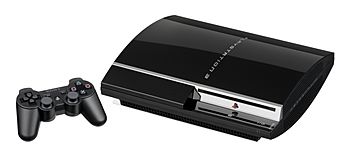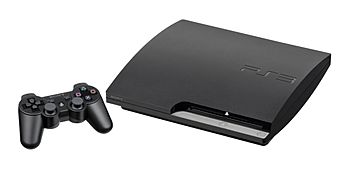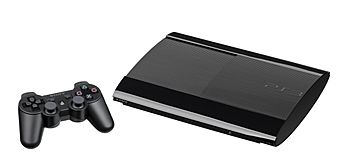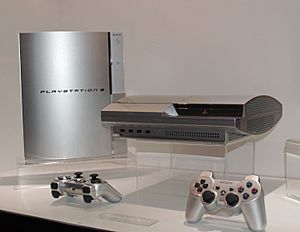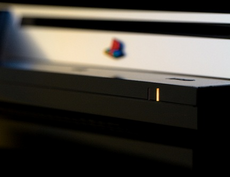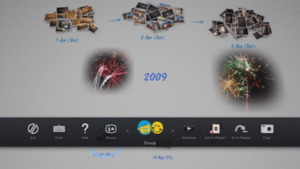PlayStation 3 facts for kids
|
|
|
|
|
| Also known as | PS3 |
|---|---|
| Developer | Sony Interactive Entertainment |
| Manufacturer | Sony, Foxconn, Asus |
| Product family | PlayStation |
| Type | Home video game console |
| Generation | Seventh |
| Release date |
|
| Retail availability | 2006–2017 (11 years) |
| Introductory price | US$499.99 (20 GB model) US$599.99 (60 GB model) |
| Discontinued | |
| Units shipped | 87.4 million (as of March 31, 2017[update]) |
| Media |
|
| Operating system | PlayStation 3 system software |
| CPU | 3.2 GHz IBM Cell Broadband Engine with 1 PPE and 8 SPEs |
| Memory | 256 MB XDR DRAM system and 256 MB GDDR3 video |
| Storage |
|
| Display | |
| Graphics | 550 MHz Nvidia/SCEI RSX Reality Synthesizer, 230 GFLOPS |
| Sound |
Audio output formats
A/V-Multi
TOSLINK
HDMI
|
| Controller input | Sixaxis, DualShock 3, DualShock 4, DualSense, Logitech Driving Force GT, Logitech Cordless Precision Controller, standard USB controllers, GT Force, rhythm game controllers, PlayStation Move, PlayStation 3 Blu-ray Remote Control, GunCon 3, PlayStation Portable, Wonderbook, PlayStation Vita, keyboard and mouse |
| Connectivity |
(details)
Flash memory input*
Audio/video output
Composite video/stereo audio cable*
Other
* All except 20 GB model |
| Online services | PlayStation Network |
| Best-selling game | Grand Theft Auto V: 34 million copies |
| Backward compatibility |
|
| Predecessor | PlayStation 2 |
| Successor | PlayStation 4 |
The PlayStation 3 (PS3) is a home video game console made by Sony Interactive Entertainment. It followed the PlayStation 2 and is part of the popular PlayStation family of consoles. The PS3 first came out on November 11, 2006, in Japan. It then launched in North America on November 17, 2006, and in Europe and Australia on March 23, 2007. The PlayStation 3 was a main competitor to Microsoft's Xbox 360 and Nintendo's Wii. These consoles were all part of the seventh generation of video game consoles.
Sony first showed the PS3 at E3 2005. It was the first game console to use Blu-ray discs for games and movies. The PS3 also introduced social gaming features like the PlayStation Network. You could even control it using handheld consoles like the PlayStation Portable and PlayStation Vita. In September 2009, a thinner and lighter version called the Slim model was released. This version had a new logo and used less power. Later, in 2012, the Super Slim model came out, making the console even smaller.
When it first launched, the PS3 got mixed reviews. It was quite expensive, and its processor was complex. Some people also felt there weren't enough great games at first. However, its Blu-ray player was praised, and many saw its "untapped potential." Over time, the console became more popular, especially after the Slim model came out. The PlayStation 4 took its place in November 2013. Sony stopped selling new PlayStation 3 units in New Zealand in 2015. Sales ended in Europe and Australia in March 2016, and in North America in October 2016. Japan was the last place to sell new PS3s until May 29, 2017, when Sony officially stopped production there.
Contents
The Story of PlayStation 3
The idea for the PlayStation 3 began on March 9, 2001. That's when Ken Kutaragi, who was the head of Sony Interactive Entertainment, announced a partnership. Sony, Toshiba, and IBM would work together to create the powerful Cell microprocessor. A team of programmers started exploring ideas for next-generation games. By 2005, Sony focused on making games ready for the PS3's launch.
Unveiling the Console
Sony officially showed the PlayStation 3 to the public on May 16, 2005, at E3 2005. They also showed a boomerang-shaped design for the Sixaxis controller. A working version of the console wasn't ready yet. However, they did show game demos like Metal Gear Solid 4: Guns of the Patriots using special development kits. They also showed a cool video based on what the PS3 could do, like a Final Fantasy VII demo.
The first design shown in 2005 had many ports. It had two HDMI ports, three Ethernet ports, and six USB ports. But a year later, at E3 2006, these were reduced to save costs. The new design had one HDMI port, one Ethernet port, and four USB ports. Sony also announced two versions: a 20 GB model for US$499 and a 60 GB model for US$599. The 60 GB model was the only one with an HDMI port, Wi-Fi, and flash card readers. Both models were planned to launch worldwide in November 2006.
Launch Day Excitement
The PlayStation 3 first launched in Japan on November 11, 2006. Over 81,000 PS3 systems were sold in Japan within 24 hours. Many people were very excited to get their hands on the new console. Ridge Racer 7 was the most popular game sold on launch day.
Soon after, the PS3 came out in North America on November 17, 2006. There were huge crowds and a lot of excitement around the release. The PS3 also launched in Hong Kong and Taiwan on the same day.
The console was supposed to launch globally in November. However, Sony delayed the release in Europe and other parts of the world until March 2007. This was because of a shortage of parts for the Blu-ray drive. On January 24, 2007, Sony announced that the PlayStation 3 would go on sale on March 23, 2007, in Europe, Australia, the Middle East, Africa, and New Zealand.
The PS3 sold 600,000 units in Europe in its first two days. It became the fastest-selling home console in the United Kingdom, selling 165,000 units in just two days. In Australia, over 27,000 units were sold in the first ten days. This showed how much people wanted the new console.
The Slim Model
People started guessing that Sony was making a thinner PS3. Sony officially announced the PS3 CECH-2000 model on August 18, 2009. This new version was much slimmer and used less power. It also had a quieter cooling system. It was released in most places by September 2009. Along with the new console, a new "PS3" logo was introduced. It looked similar to the PlayStation 2 logo.
The Super Slim Model
In September 2012, Sony announced an even slimmer PS3 redesign (CECH-4000) at the Tokyo Game Show. This model was released later in 2012. It came with either a 250 GB or 500 GB hard drive. There was also a 12 GB flash storage version available in some regions. This 12 GB model could be upgraded with a separate hard drive.
The Super Slim model is 20 percent smaller and 25 percent lighter than the Slim model. It has a manual sliding disc cover instead of the automatic slot-loading one. Different colors like Garnet Red and Azurite Blue were also released later.
Awesome Games for PS3
The PlayStation 3 launched in North America with 14 games. Three more games came out before the end of 2006. Resistance: Fall of Man was the best-selling launch game in North America. Many gaming websites praised it. In Japan, Ridge Racer 7 was the top-selling game at launch.
The PS3 launched in Europe with 24 games. These included games not available at the North American and Japanese launches, like Formula One Championship Edition and MotorStorm. Resistance: Fall of Man and MotorStorm were very popular in 2007. Both games later got sequels.
At E3 2007, Sony showed many exciting upcoming games. These included Heavenly Sword, Ratchet & Clank Future: Tools of Destruction, and Uncharted: Drake's Fortune. They also showed games for 2008 and 2009, like Killzone 2 and LittleBigPlanet. Many popular games from other companies also came to PS3, such as Metal Gear Solid 4: Guns of the Patriots and Grand Theft Auto IV.
Sony also created budget-friendly versions of popular PS3 games. These were called the Greatest Hits range in North America and the Platinum range in Europe. Some games in this range included Resistance: Fall of Man, MotorStorm, and Uncharted: Drake's Fortune.
As of March 31, 2012, over 595 million games were sold for the PlayStation 3. The best-selling PS3 games include Grand Theft Auto V, Gran Turismo 5, and The Last of Us. The very last game released on the PlayStation 3 was Shakedown: Hawaii, on August 20, 2020.
Games in 3D
In 2008, a game studio called Blitz Games announced they would bring 3D gaming to the PS3. Sony showed this off in January 2009 at the Consumer Electronics Show. They showed Wipeout HD and Gran Turismo 5 Prologue in 3D.
Later, a system update (firmware 3.30) allowed PS3 games to be played in 3D. You needed a special 3D TV to see it. Games could also be updated to add 3D features later. Some games that got 3D updates included Wipeout HD and Pain.
How the PS3 Works
The PlayStation 3 has a unique design. It's curved on one side and has a shiny black finish. The PlayStation logo stands upright when the console is vertical. The designer, Teiyu Goto, said the logo inspired the PS3's shape.
The PlayStation 3 has a special Blu-ray Disc drive. It plays games, Blu-ray movies, DVDs, and CDs. The console originally came with 20 GB or 60 GB hard drives. Over time, models with up to 500 GB became available. You can also upgrade the hard drive yourself.
The PS3 uses a powerful processor called the Cell microprocessor. Sony, Toshiba, and IBM designed it together. This CPU helps the console run games smoothly. The graphics are handled by the Nvidia RSX 'Reality Synthesizer chip. This chip can create amazing visuals from standard definition up to 1080p HD. The PS3 has 256 MB of main memory and 256 MB of video memory for graphics.
The system also has Bluetooth 2.0, Gigabit Ethernet for internet, and USB 2.0 ports. Most models also have Wi-Fi built-in. Some older models even had a flash card reader for Memory Stick, SD, and CompactFlash cards.
Different PS3 Models
The PlayStation 3 came in a few different versions: the original, the Slim, and the Super Slim. Each new model changed some features. They also made the console cheaper and lighter. Storage space often increased with newer models.
Controllers and Cool Accessories
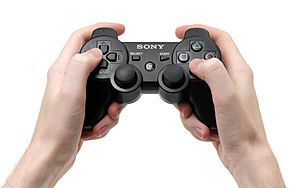
Many accessories were made for the PS3. These include the wireless Sixaxis and DualShock 3 controllers. Other accessories were the PlayStation Eye camera and the PlayTV tuner for watching TV.
At E3 2006, Sony announced the Sixaxis controller. It looked like the PlayStation 2's DualShock 2 controller but was wireless. It also had motion sensors, so you could control games by moving the controller.
Later, at the 2007 Tokyo Game Show, Sony announced the DualShock 3. This controller had the same motion sensing as the Sixaxis but also included vibration. It felt heavier and offered strong vibrations, similar to the DualShock 2. It was released in Japan in November 2007 and in other regions later.
During E3 2009, Sony showed plans for a motion controller called PlayStation Move. It came out in September 2010. This allowed players to use their body movements to control games. The PlayStation 3 can also use the DualShock 4 controller from the PS4.
Console Reliability
Like any electronic device, some PlayStation 3 consoles experienced issues. A common problem was known as the "yellow light of death" (YLOD). This light would appear if there was a problem with the console. Sony stated that only a small number of consoles had this issue.
PS3 Software
The PlayStation 3's software, called System Software, can be updated. You can download updates directly from the PlayStation Network if your PS3 is connected to the internet. You can also download updates to a computer and then put them on your PS3 using a USB drive. Sometimes, game discs even come with updates you need to install to play the game.
Older PlayStation 3 models could also install other operating systems, like Linux. However, this feature was removed from newer Slim models. It was also removed from older PS3s with a software update in April 2010. Sony said this was for security reasons.
Easy to Use Menu
The PlayStation 3 uses a menu system called the XrossMediaBar (XMB). It's pronounced "Cross Media Bar." This menu has nine main categories: Users, Settings, Photo, Music, Video, TV/Video Services, Game, Network, PlayStation Network, and Friends. It's similar to the menu on the PlayStation Portable.
The XMB lets you create user profiles, look at photos, and play music. You can copy music from CDs to the PS3's hard drive. You can also watch movies and videos from Blu-ray discs, DVDs, or a USB drive. The PS3 also has a web browser and lets you video chat if you have a PlayStation Eye camera. The Network menu lets you visit the PlayStation Store and connect to a PlayStation Portable using Remote Play.
Photo Fun
- Photo Gallery
The Photo Gallery is a special app for viewing and organizing photos on your PS3. It was added in system software version 2.60. This app helps you sort photos in different ways, like by colors or even by people's facial expressions. You can also watch slideshows with music. Later updates allowed you to upload photos to Facebook and Picasa.
- PlayMemories Studio
PlayMemories is another app for viewing photos, especially 3D ones. You can zoom into 3D pictures and change your view. To see 3D images properly, you need a 3D HDTV and an HDMI cable.
Video Services
- Video Editor and Uploader
A video editing app was released with system software version 3.40. It allowed you to edit videos right on your PlayStation 3. You could cut videos, add music, and put in captions. Then, you could upload your edited videos to websites like Facebook and YouTube.
- Streaming Movies and Shows
The PlayStation 3 offered many video streaming services. In Europe, Australia, and New Zealand, VidZone offered free music videos. In the United States, Netflix became available in November 2009. You needed a Netflix subscription to use it.
Other services like MLB.tv and MUBI also came to the PS3. Later, VUDU, NHL GameCenter Live, and Hulu Plus launched in the United States. In 2012, Amazon.com also launched its Amazon Video app for Prime subscribers.
Music on PS3
The PlayStation 3 can play regular audio CDs. This was a feature that was removed from later PlayStation consoles. You could also copy music from CDs to the PS3's hard drive. You could save them as MP3, AAC, or Sony's own ATRAC format. Some early models could even play Super Audio CDs. You could also play music from portable players by connecting them to the PS3's USB port.
Leap Year Bug
On March 1, 2010, many original PlayStation 3 consoles around the world had a problem with their internal clock. The console's clock incorrectly thought 2010 was a leap year. This caused problems connecting to the PlayStation Network and even playing some offline games. The console's date would sometimes jump back to December 31, 1999. This event was nicknamed the ApocalyPS3.
Sony quickly confirmed the error and worked to fix it. By March 2, 2010, most original PS3 owners could connect to PSN again. Sony released a system update (3.40) on June 29, 2010, to fix the clock issue permanently.
Connecting with PlayStation Portable
The PlayStation Portable (PSP) could connect with the PlayStation 3 in many ways. For example, in the racing game Formula One Championship Edition, you could use your PSP as a real-time rear-view mirror. You could also download original PlayStation games from the PlayStation Store and play them on both your PSP and PS3.
A cool feature called Remote Play allowed you to play some PS3 games remotely on your PSP. You could do this over a local network or even over the internet from anywhere in the world. Sony also showed the PSP playing videos stored on the PS3's hard drive wirelessly.
PlayStation Network: Your Online Hub
The PlayStation Network (PSN) is Sony's online service for PlayStation 3 and PlayStation Portable. It was announced in 2006. PSN is free to use and lets you play games online with friends. It also gives you access to the PlayStation Store and other services. You can use real money or PlayStation Network Cards to buy things on PSN.
PlayStation Plus: Extra Goodies
PlayStation Plus (PS+) is a special paid subscription service for the PlayStation Network. It was announced at E3 2010. PS+ gives you extra benefits on PSN, while the basic PSN service remains free. These benefits include games and updates downloading automatically to your PS3. Subscribers also get early access to game demos, special downloadable content, and other items from the PlayStation Store. You can buy a one-year or a three-month subscription to PlayStation Plus.
PlayStation Store: Digital Games and More
The PlayStation Store is an online shop for PlayStation 3 and PlayStation Portable users. It's part of the PlayStation Network. The Store offers lots of digital content, some for purchase and some for free. You can find full games, extra content for games, playable demos, themes for your console, and game and movie trailers. You can access the Store from the XMB on your PS3.
The PlayStation Store gets new content every Tuesday in North America and every Wednesday in Europe and Australia. As of September 24, 2009, there had been over 600 million downloads from the PlayStation Store worldwide.
In March 2021, Sony announced they would close the PS3 Store. However, after many fans shared their feedback, Sony changed their mind in April 2021. The PS3 Store remains open for users.
What's New: Latest Updates
What's New was a feature released in September 2009 with PlayStation 3 system software 3.0. It replaced the old "Information Board." This feature showed you a ticker of all the latest content. It displayed recently played games, news, and new content available in the PlayStation Store. It was a quick way to see what was new and exciting on your PS3.
PlayStation Home: A Virtual World
PlayStation Home was a 3D social networking service for the PlayStation Network. It was like a virtual world where you could create your own custom character. You could decorate your own apartment and meet up with friends. You could also shop for new items or win prizes from PS3 games. Home was a place to hang out, chat, and even play multiplayer games with others.
PlayStation Home started as a test in May 2007 and became an open test in December 2008. It stayed in a "beta" stage until it closed on March 31, 2015. Membership was free, but you needed a PSN account. When it closed, over 41 million users had downloaded Home.
Life with PlayStation: News and More
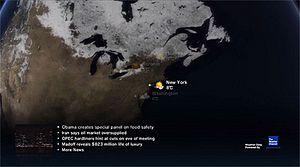
Life with PlayStation was an app released in September 2008. It showed news and information from different cities around the world. It also included weather forecasts and news headlines from sources like Google News and The Weather Channel. The app also had channels about World Heritage sites and a "United Village" channel to share information about communities worldwide. This app was retired on November 6, 2012.
PlayStation Network Outage
On April 20, 2011, Sony temporarily shut down the PlayStation Network. They announced on April 23 that this was due to "an external intrusion on our system." This meant someone had hacked into their system. Sony later said that personal information of 77 million users might have been taken. This included names, addresses, email addresses, birthdates, and PSN logins. There was no proof that credit card details were taken, but Sony advised customers to be careful.
To make up for this, Sony launched a "Welcome Back" program. All PSN members received 30 days of free PlayStation Plus membership. They also got two free downloadable PS3 games.
PS3 Sales and Costs
| Region | Units sold | First available |
|---|---|---|
| Canada | "about 1.5 million" as of October 6, 2010[update] | November 17, 2006 |
| Europe (Includes UK and other PAL regions) |
30 million as of December 19, 2012[update] | March 23, 2007 |
| Japan | 9.3 million as of June 27, 2013[update] | November 11, 2006 |
| United Kingdom | 5.5 million as of June 27, 2013[update] | March 23, 2007 |
| United States | 22.9 million as of June 27, 2013[update] | November 17, 2006 |
| Worldwide | 87.4 million (as of March 31, 2017[update]) | November 11, 2006 |
The PlayStation 3 had a tough start compared to earlier PlayStations. It was very expensive to make and sell. The PS3 also faced strong competition from the Wii, which was cheaper and had unique motion controls. It also competed with the Xbox 360, which came out earlier.
Sony lost money on each PS3 console sold for a few years. However, the redesigned "Slim" PS3 helped reduce these losses. By August 2009, Sony had cut the manufacturing costs by 70%. This meant it cost Sony much less to make each console.
In January 2009, Sony announced that its gaming division was finally making a profit. The PS3 eventually sold 87.4 million units worldwide by March 2017.
Images for kids
See also
 In Spanish: PlayStation 3 para niños
In Spanish: PlayStation 3 para niños



